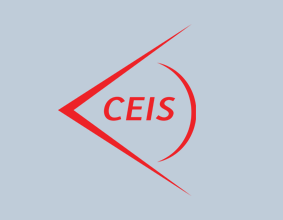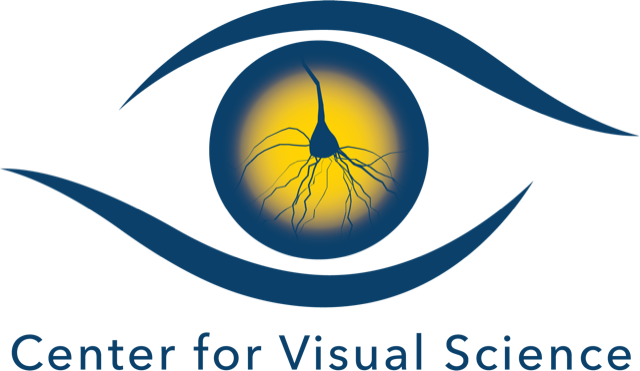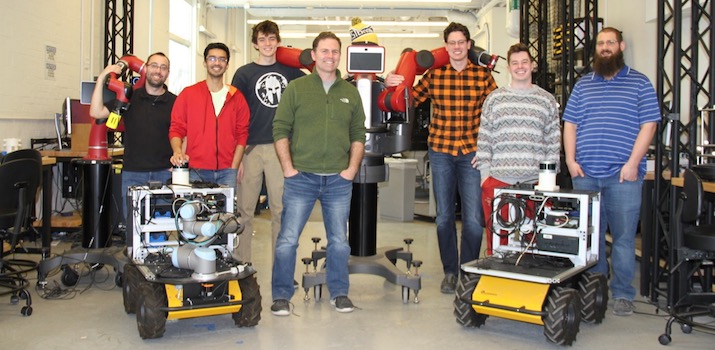Centers and Labs

Our Connected Research Network
Research is one of the most valuable experiences a student can have.
At the Department of Electrical and Computer Engineering (ECE) we look to change the world around us for the better through innovation, research, and collaborative efforts.
ECE provides leadership for University-level initiatives ranging from nanotechnology and audio research to communications and engineering research.
See the University of Rochester research page for a full listing of research centers across the University.
Audio Information Research (AIR) Lab
 At the AIR lab, research is conducted in the emerging field of computer audition, i.e., designing computational systems that are able to analyze and understand sounds including music, speech, and environmental sounds. Fundamental issues such as parsing polyphonic auditory scenes (the cocktail party effect), as well as design novel applications such as sound retrieval and music information retrieval are addressed. Sound analysis is combined with the analysis of other signal modalities such as text and video towards multi-modal scene analysis. Various projects include audio source separation, automatic music transcription, audio-score alignment, speech enhancement, speech diarization and emotion recognition, sound retrieval, sound event detection, and audio-visual scene understanding.
At the AIR lab, research is conducted in the emerging field of computer audition, i.e., designing computational systems that are able to analyze and understand sounds including music, speech, and environmental sounds. Fundamental issues such as parsing polyphonic auditory scenes (the cocktail party effect), as well as design novel applications such as sound retrieval and music information retrieval are addressed. Sound analysis is combined with the analysis of other signal modalities such as text and video towards multi-modal scene analysis. Various projects include audio source separation, automatic music transcription, audio-score alignment, speech enhancement, speech diarization and emotion recognition, sound retrieval, sound event detection, and audio-visual scene understanding.
Center for Emerging and Innovative Sciences (CEIS)
 The Mission of CEIS is to promotes economic development in New York State by bringing together companies and university researchers who have areas of common interest and encouraging collaboration through funding and outreach.
The Mission of CEIS is to promotes economic development in New York State by bringing together companies and university researchers who have areas of common interest and encouraging collaboration through funding and outreach.
Center for Visual Science (CVS)
 The Center for Visual Science at the University of Rochester was founded in 1963 by Robert M. Boynton to bring together scientists from a variety of disciplines with the common goal of pursuing excellence in vision research. CVS consists of more than 30 research laboratories that include faculty from across the University.
The Center for Visual Science at the University of Rochester was founded in 1963 by Robert M. Boynton to bring together scientists from a variety of disciplines with the common goal of pursuing excellence in vision research. CVS consists of more than 30 research laboratories that include faculty from across the University.
Laboratory for Laser Energetics (LLE)
 LLE is a unique setting where scientists study laser fusion and where atoms of hydrogen are heated so fast by a giant laser that they fuse, creating bursts of energy - the same process that powers the sun and other stars. LLE is the largest unclassified laboratory of its kind in the nation.
LLE is a unique setting where scientists study laser fusion and where atoms of hydrogen are heated so fast by a giant laser that they fuse, creating bursts of energy - the same process that powers the sun and other stars. LLE is the largest unclassified laboratory of its kind in the nation.
Robotics and Artificial Intelligence Laboratory (RAIL)
 The Robotics and Artificial Intelligence Laboratory (RAIL) is a interdisciplinary research laboratory at the University of Rochester. Located in Gavett Hall, this researchers here investigate algorithms and models for robot intelligence and human-robot interaction in complex, uncertain, and dynamic environments to advance robotic exploration, manufacturing, rehabilitation, and medicine. The laboratory houses twenty research robots, including mobile robots, unmanned ground vehicles, robotic torsos and manipulators, mobile manipulators, and small humanoid robots.
The Robotics and Artificial Intelligence Laboratory (RAIL) is a interdisciplinary research laboratory at the University of Rochester. Located in Gavett Hall, this researchers here investigate algorithms and models for robot intelligence and human-robot interaction in complex, uncertain, and dynamic environments to advance robotic exploration, manufacturing, rehabilitation, and medicine. The laboratory houses twenty research robots, including mobile robots, unmanned ground vehicles, robotic torsos and manipulators, mobile manipulators, and small humanoid robots.
Rochester Center for Biomedical Ultrasound (RCBU)
 Engineers from several engineering departments and physicians from the Medical Center work together to understand and develop new methods of using ultrasound in the diagnosis and treatment of disease, for example, cancerous tumors of the prostate or breast.
Engineers from several engineering departments and physicians from the Medical Center work together to understand and develop new methods of using ultrasound in the diagnosis and treatment of disease, for example, cancerous tumors of the prostate or breast.
Laboratory for Nanophotonics : Quantum, Nonlinear and Mechanical Photonics
 We are an energetic and synergistic team of scholars with strong curiosity and passion for micro/nanophotonic technology. We come from very different backgrounds in physics, optics, photonics, electrical engineering, and others. But we share a common interest in using our creativity and combining our expertise to explore new physics and to develop new applications via engineered micro/nanoscopic photonic structures.
We are an energetic and synergistic team of scholars with strong curiosity and passion for micro/nanophotonic technology. We come from very different backgrounds in physics, optics, photonics, electrical engineering, and others. But we share a common interest in using our creativity and combining our expertise to explore new physics and to develop new applications via engineered micro/nanoscopic photonic structures.
Medical Imaging Research Group (MIRG)
 The mission of the Medical Imaging Research Group (MIRG) is to develop novel imaging methods for detecting disease more quickly and for determining how well patients are responding to therapy. Current research includes:
The mission of the Medical Imaging Research Group (MIRG) is to develop novel imaging methods for detecting disease more quickly and for determining how well patients are responding to therapy. Current research includes:
- Monitoring the response of pancreatic cancer to chemotherapy, radiation therapy, and targeted therapy.
- Determining how inflammation and cART affect the vascular integrity of individuals infected with HIV.
- Developing contrast-enhanced ultrasound imaging methods for visualizing vasculature at a high spatial resolution.
We are located on the 7th floor of the Computer Studies Building at the University of Rochester. If you are interested in collaborating with us or in joining the MIRG team, please contact Marvin Doyley at m.doyley@rochester.edu.
Parker Medical Imaging Research Lab
 Projects are underway in a number of areas related to medical imaging, image processing and novel scanning techniques. All of these are built on the fundamentals of wave propagation combined with signal and image processing techniques. Many projects are undertaken in joint facilities of the Department of Electrical and Computer Engineering and the Department of Imaging Sciences (Radiology) at the University of Rochester Medical Center.
Projects are underway in a number of areas related to medical imaging, image processing and novel scanning techniques. All of these are built on the fundamentals of wave propagation combined with signal and image processing techniques. Many projects are undertaken in joint facilities of the Department of Electrical and Computer Engineering and the Department of Imaging Sciences (Radiology) at the University of Rochester Medical Center.
See the project links for more details including recent innovations such as the needle pulse, the H-scan, and the uses of reverberant shear wave fields.
Laboratory for Advanced Integrated Circuits and Systems
 Our group is conducting research in the fields of integrated high-speed electronics and photonics. We are focusing on the following research directions: High-speed integrated circuits and systems; Inter- and intra-chip electrical interconnects; Optical interconnects; Silicon photonics; Electronic-photonic integrated circuits (EPIC); Smart wireless and free-space optical sensors; High-performance clocking in microprocessors and SoCs; Ultra-wideband (UWB) radios and radars; Energy-efficient RF oscillators.
Our group is conducting research in the fields of integrated high-speed electronics and photonics. We are focusing on the following research directions: High-speed integrated circuits and systems; Inter- and intra-chip electrical interconnects; Optical interconnects; Silicon photonics; Electronic-photonic integrated circuits (EPIC); Smart wireless and free-space optical sensors; High-performance clocking in microprocessors and SoCs; Ultra-wideband (UWB) radios and radars; Energy-efficient RF oscillators.
Nanoelectric and Quantum Device Laboratory
 As we reach the era of post-Moore’s law electronics, there is a critical need for new types of nanoelectronic devices that go beyond the conventional transistor for the continued advancement of computing. Low power, fast switching, non-volatile electronic devices that operate on fundamentally different principles represent the next step in the evolution of what the landscape of electronics will look like for the coming years.
As we reach the era of post-Moore’s law electronics, there is a critical need for new types of nanoelectronic devices that go beyond the conventional transistor for the continued advancement of computing. Low power, fast switching, non-volatile electronic devices that operate on fundamentally different principles represent the next step in the evolution of what the landscape of electronics will look like for the coming years.
We are focused on using engineered quantum materials to create next generation nanoelectronic and quantum electronic devices. Please check out the other areas of our website for more information!
